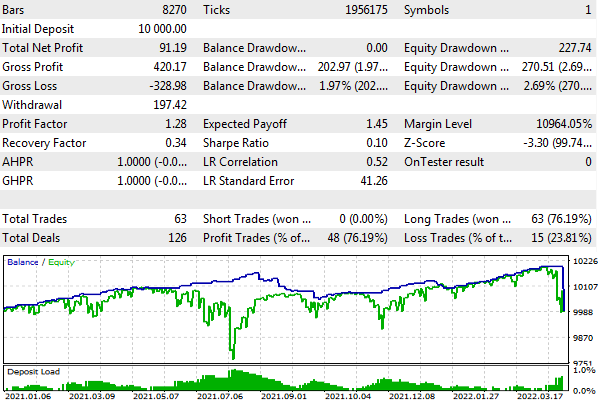- Generating ticks in tester
- Time management in the tester: timer, Sleep, GMT
- Testing visualization: chart, objects, indicators
- Multicurrency testing
- Optimization criteria
- Getting testing financial statistics: TesterStatistics
- OnTester event
- Auto-tuning: ParameterGetRange and ParameterSetRange
- Group of OnTester events for optimization control
- Sending data frames from agents to the terminal
- Getting data frames in terminal
- Preprocessor directives for the tester
- Managing indicator visibility: TesterHideIndicators
- Emulation of deposits and withdrawals
- Forced test stop: TesterStop
- Big Expert Advisor example
- Mathematical calculations
- Debugging and profiling
- Limitations of functions in the tester
Emulation of deposits and withdrawals
The MetaTrader 5 tester allows you to emulate deposit and withdrawal operations. This allows you to experiment with some money management systems.
bool TesterDeposit(double money)
The TesterDeposit function replenishes the account in the process of testing for the size of the deposited amount in the money parameter. The amount is indicated in the test deposit currency.
bool TesterWithdrawal(double money)
The TesterWithdrawal function makes withdrawals equal to money.
Both functions return true as a sign of success.
As an example, let's consider an Expert Advisor based on the "carry trade" strategy. For it, we need to select a symbol with large positive swaps in one of the trading directions, for example, buying AUDUSD. The Expert Advisor will open one or more positions in the specified direction. Unprofitable positions will be held for the sake of accumulating swaps on them. Profitable positions will be closed upon reaching a predetermined amount of profit per lot. Earned swaps will be withdrawn from the account. The source code is available in the CrazyCarryTrade.mq5 file.
In the input parameters, the user can select the direction of trade, the size of one trade (0 by default, which means the minimum lot), and the minimum profit per lot, at which a profitable position will be closed.
enum ENUM_ORDER_TYPE_MARKET
|
First, let's test in the handler OnInit the performance of functions TesterWithdrawal and TesterDeposit. In particular, an attempt to withdraw a double balance will result in error 10019.
int OnInit()
|
But the subsequent withdrawals and crediting back of 100 units of the account currency will be successful.
PRTF(TesterWithdrawal(100));
|
In the OnTick handler, let's check the availability of positions using PositionFilter and fill the values array with their current profit/loss and accumulated swaps.
void OnTick()
|
When there are no positions, we open one in a predefined direction.
if(ArraySize(tickets) == 0) // no positions
|
When there are positions, we go through them in a cycle and close those for which there is sufficient profit (adjusted for swaps). While doing so, we also sum up the swaps of closed positions and total losses. Since swaps grow in proportion to time, we use them as an amplifying factor for closing "old" positions. Thus, it is possible to close with a loss.
double loss = 0, swaps = 0;
|
If the total losses increase, we periodically open additional positions, but we do it less often when there are more positions, in order to somehow control the risks.
if(loss / ArraySize(tickets) <= -MinProfitPerLot * volume * sqrt(ArraySize(tickets)))
|
Finally, we remove swaps from the account.
if(swaps >= 0)
|
In the OnDeinit handler, we display statistics on deductions.
void OnDeinit(const int)
|
For example, when running the Expert Advisor with default settings for the period from 2021 to the beginning of 2022, we get the following result for AUDUSD:
final balance 10091.19 USD
|
Here is what the report and graph look like.

Expert report with withdrawals from the account
Thus, when trading a minimum lot and loading a deposit of no more than 1% for a little over a year, we managed to withdraw about 200 USD.